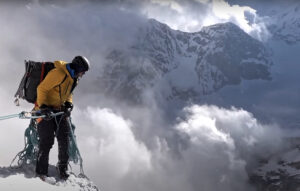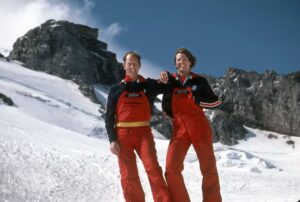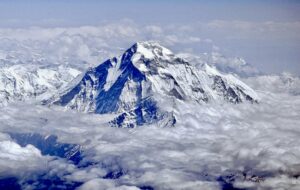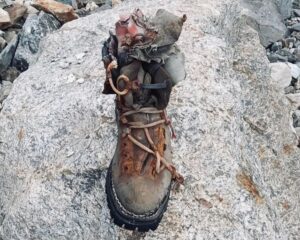In 2012, German mountaineer Ralph Dujmovits took a turn for the worse on Everest. He had been taking antibiotics for a sinus infection, and the combination of the drugs and the altitude made him feel wretched. Reluctantly he turned back from his summit push and descended.
Just below the traverse to Camp 3 he spotted what would become the most iconic photo of Everest’s commercialization: an endless Conga line of climbers in apparent gridlock, waiting for their turn to ascend the highest mountain in the world.

Ralph Dujmovits snapped a line of climbers snaking their way up Everest: “I almost couldn’t believe what I saw, that so many people made the decision to go up at the same time.” Photo: Ralph Dujmovits
It was my hope to make more people understand that this has nothing to do with mountaineering, that it’s a trophy hunt. But I don’t think people got the message.
The idea that Everest has become gentrified, commercialized, and even disrespected, has only gathered momentum since 2012. In 2013, there were a record 658 summits, and there have been a colossal 8,306 total summits since Tenzing Norgay and Sir Edmund Hillary first stood atop the world in 1953.
The increasing number of visitors, as well as the rise of large commercial operations, has dismayed climbing purists. A common sentiment is that “one should be there for the love of climbing, and not the Facebook post of oneself at the summit.” Criticism has sometimes been couched in terms of safety: Surely a base level of competency should be established in order to climb the mountain? They also view the mountain in terms of traditional gentrification, where in future serious climbers are priced out, leaving Everest covered with inexperienced but wealthy tourists.

The Hillary Step became a bottleneck for the increasing number of climbers on Everest. Photo: Adrian Ballinger
The charge that Everest no longer has anything to do with mountaineering, at least at the top end of the luxury commercial spectrum, does seem to hold water. The highest priced commercial operators, such as Furtenbach, are certainly making life easier for their clients. Reinhold Messner famously remarked that using supplemental oxygen at just two litres per minute makes an 8,000m peak the equivalent of a 7,000m peak. Furtenbach regularly supply clients with oxygen at eight litres per minute.
So what does that make Everest during one of their infamous “flash climbs”? Some operators now supply hypoxic tents to minimize acclimatization time, while the well-appointed Base Camps of both Tibet and Nepal, complete with helicopter pads, bars and kitchens, provide further ammunition for those taking aim at peak-bagging tourists seen to be vacationing in “real” mountaineers’ terrain.

Waste disposal on Everest has become a real problem, forcing Nepal’s government to introduce rubbish quotas for each individual returning from the mountain. Photo: Profimedia.cz
Differentiating levels of achievement is nothing new in mountaineering, but those glorifying the incredible ascents of the last century should remember the siege-style tactics used by those classic expeditions. This involved lugging hampers of luxury items to the mountains, usually on the backs of a quite staggering number of Sherpas. Perhaps the overly romanticized ideal of a mountaineer is what needs to change. When the first American reached the summit of Mount Everest in 1963, the New York press reported that as Jim Whittaker “stood at the summit, accompanied by his Sherpa guide, both men were very much alone.” They failed to point out that it had taken a small army of 900 lowland Sherpas to get them there.

Sherpa are still relied upon to do much of the hard graft, working in dangerous conditions both to ferry goods to the camps, and to secure the route to the summit of Everest. Photo: National Geographic
Those involved in modern top-end expeditions are quick to point out that the safety of their clients is their paramount concern. They argue that most of the “luxuries” serve a serious purpose. The use of high concentration supplemental oxygen, and the decision to stick to the traditional South Col route secured by the Icefall Doctors, do significantly decrease the risk of fatalities. Of the total deaths on Everest, 27 percent have come on non-standard routes, despite accounting for only 265 of the 8,306 total summits. Meanwhile, the death rate for those attempting to summit with supplemental oxygen is nearly half the rate of those climbing without.
Criticisms regarding costs and gentrification are also quick to be countered by some of those working the mountain. The bifurcation on Everest (in which the divide between top-end providers and budget operators seemingly increases each year) is well documented. However, the impression of Everest as more expensive than ever before may be a question of optics.
Everest has long been the domain of the privileged few. Previously, expedition participants may not have been paying huge sums of money directly to a mountaineering company, but the cost of staging expeditions was prohibitive. This, in turn, led to a certain strata of society dominating early Everest history. Climbers were highly educated and from the upper middle classes. In addition, for most of the developing world, even the idea of climbing Everest was outside the realm of possibility until recently. True global tourism is a modern phenomenon. To suggest that climbing Everest is no longer an achievement seems profoundly unfair to those born outside the West.

Sibusiso Vilane became the first black African to summit Everest in 2003. Photo: David Hamilton
That leaves us with criticisms about ethos and mindset. Peak-bagging and ego have always been part of mountaineering, but there seems to be a certain level of derision reserved for those seen to be stroking their egos without doing the hard yards. For some, the hordes of new climbers are tainting, or lessening, the achievement of climbing Everest. But perhaps we just need to put the various styles of climbing into proper context. The decline of siege climbing and a move towards lightning fast, ultra-light, alpinism is great for the environment, but it also serves to differentiate “real” mountaineers from those now flocking to Everest with commercial expeditions. True alpinism is beyond most people, but to suggest that others’ achievements must always be stacked against those of the best practitioners seems unnecessary. There is room enough for different levels of accomplishment on Everest.

Double amputee Everest climber Xia Boyu is a great example of how levels of achievement do not need to be a one-size-fits-all model. Photo: Everest Today
The world has changed since 1953, so it shouldn’t be surprising that Everest has changed too. Pointing the finger at commercial operations seems to be missing the point: Whether queueing on the Hillary Step, rubbish-strewn slopes or climbers callously stepping over those in trouble on their way to the summit, there have always been those who have respected the mountain and those that have not. Humanity has not changed, but the sheer volume of traffic, and the amount of money to be made, has. The solution seems obvious: limit the number of people climbing each season. It’s the selection process of who gets to go that may prove impossible.






